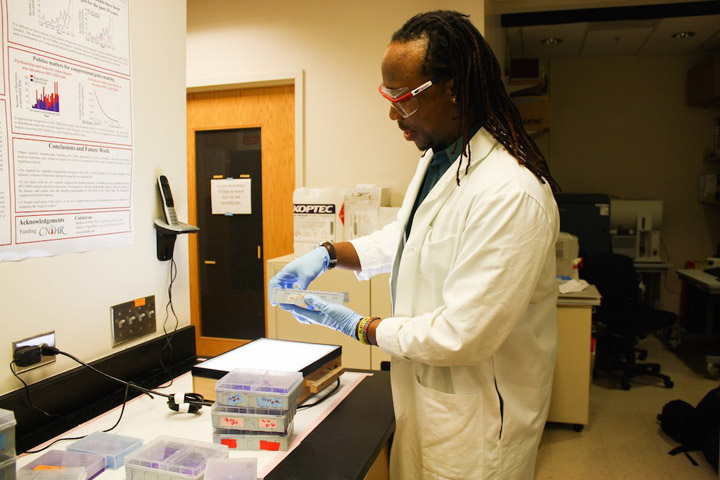Tackling Disease by Catherine Chou

Nestled in the back of IBB is a three-pronged weapon: Prof. Manu Platt's lab. Through work in repair, remodeling, and regeneration, Platt and his students are tackling sickle cell anemia, HIV and AIDS, and breast cancer. All three avenues have made considerable progress, thanks to a combination of hard work and dedication.
Sickle cell anemia is a blood disorder caused by a single point mutation: adenine to thymine, which changes the shape of red blood cells in the body. In regular cases, individuals have fifty to seventy years to accumulate lipids and build plaque before they have a stroke. However, children with sickle cell disease mutation between the ages of two to five have been shown to have the greatest risk of having a stroke; in fact, 15% have strokes that are physically debilitating, while 35% have strokes that are mentally impairing. What Platt's lab aims to do, then, is to investigate why this occurs: how is this lipid-free vascular remodeling happening? How is sickle cell related to cardiovascular disease? Which children with sickle cell are at the most risk for stroke?
A unique approach to this question, through the investigation of cathepsin levels, has led Platt to receive $1.5M from NIH in 2010, given to "exceptionally creative new investigators who propose highly innovative projects with potential for unusually high impact" (IBB). Cathepsin is a protease that has been identified in lysosomes and is capable of degrading structural proteins in the artery wall and thus changing cell phenotype and function. Furthermore, cathepsins have been seen to be overexpressed in cardiovascular diseases. Unfortunately, however, cathepsins die out quickly in the body - they have active life spans of two to three hours - and so, despite the high activity, they are unstable and difficult to work with.
With this grant, along with an exceptionally efficient assay his team developed that rivals Western blots, ELISA, and others in its ability to detect cathepsin in femtomole quantities, Platt has carried out multiple projects, including the latest - the use of computation fluid dynamics to mimic blood flow during the cardiac cycle and look at how stiff blood cells, such as sickle cells, disturb the blood flow. This simulated reversal of blood flow "causes all these genes and proteins that cause disease to be turned by endothelial cells - including my cathepsins!" exclaims the ever-enthusiastic Platt. He has further found proof that not only is there a correlation between cathepsins and HIV, but cathepsins and a certain HIV protein are correlated as well. Working alongside a clinic in South Africa, they track cathepsin in the blood at 6, 12, 18 then 24 months for the same patients, taking a three antiretroviral drug 'cocktail' used to treat HIV. Patients taking their medications properly usually have had the cathepsin level drop to undetectable levels after either the six or twelve-month period. Recently having finished the 18-month checkup, Platt has hope that this project will have wonderful outcomes. Instead of current tedious, time-inefficient and expensive method of monitoring patient adherence to their drugs via mass spectrometry, a system may be created requiring only a drop of blood and a short period of time for cathepsin analysis. Current projects looking to improve, such as HIV prevention gels, could also benefit from this type of research.
Meanwhile, the Platt Lab also conducts research on breast cancer, specifically in the field of early detection and personalized treatment. Current pre-screening methods are detecting the cancer earlier, but not necessarily reducing deaths to breast cancer. What Platt's researchers are doing now, then, is taking white blood cells from patients at the DeKalb Medical Center, turning them into macrophages and determining which patients' cells have the most activity. They have also looked at and published a paper on measuring cell signals during the differentiation to predict how malignant a person's macrophages will be and thus how likely said patient will develop aggressive breast cancer.
Dong-hee "Justin" Chang, an undergraduate working with MD/PhD student Keon-young Park, has also provided related insight into the lab's investigation of cathepsin, monocytes and osteoclasts for the purposes of detecting cancer early. The pair's project is focused on the idea that a huge population of females receives unnecessary mastectomies due to the detection of DCIS (ductal carcinoma in situ), which in itself is not necessarily malignant. More specifically, they are "looking to determine exactly how cathepsins affect cancer progression and find possible targets of inhibition," with the hypothesis being that patients who produce more cathepsin in their tumor associated macrophages (TAM) and cancer cells will have faster cancer progression.
When all is said and done, Platt and his team are making an immense and global impact. AIDS 2012 and IPS (International Proteolysis Society) 2013, two conferences that took place in Africa, have seen presentations by many members of the Platt Lab, and a few individuals even stayed to carry out field research complementing work being done at Georgia Institute of Technology. Platt himself also returned to South Africa this past December to speak at ICASA (International Conference on AIDS and STIs in Africa). Moreover, while here in the United States, he collaborated with his brother, Dr. Matthew Platt, on a paper investigating how scientific discoveries have affected HIV and AIDS-related bills presented to Congress. Throughout all of this and in addition to many other achievements, Platt remains humble. When asked about his greatest lab-related accomplishment, he replied with "I had a moment of wow, I was able to take six of my lab students to South Africa for a conference [in October] where they all presented... this was really something that when I started the job I never thought I would do. Things just open up, doors just open up, opportunities open up. That was really something." And as Platt has proven, so is his passion for helping people.
28 January 2014 Tackling Diseases
Copyright © 2013-2014 Pioneer Magazine
